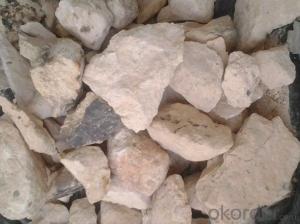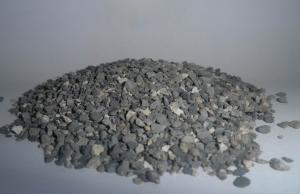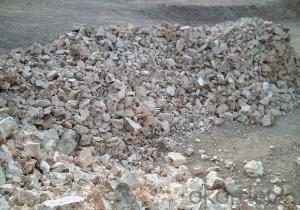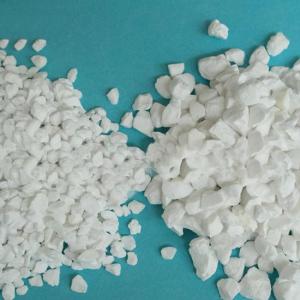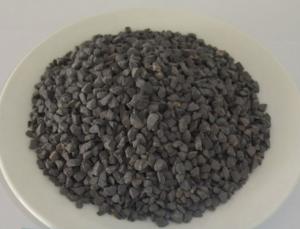Raw Materials for Refractory:Shaft Kiln Calcined Bauxite by CNBM in China
- Loading Port:
- Tianjin
- Payment Terms:
- TT OR LC
- Min Order Qty:
- 11 m.t.
- Supply Capability:
- 10000000 m.t./month
OKorder Service Pledge
OKorder Financial Service
You Might Also Like
Shaft Kiln Calcined Bauxite of CNBM in China
1.Structure of Calcined Bauxite Description of CNBM in China
Bauxite (aluminous soil; Bauxite) is also called the alumina or bauxite, main ingredients are alumina, hydrated alumina containing impurities, is an earthy mineral. White or gray, brown and yellow or light red by iron. From 4 to 3.9 g/cm3 density, hardness, 1 ~ 3 is not transparent, very brittle. Very difficult to melt. Insoluble in water, soluble in sulfuric acid, sodium hydroxide solution. Mainly used for aluminium, refractory material.
2.Main Features of the Calcined Bauxite of CNBM in China
Calcined bauxite is one of the principal ore of aluminum. Calcined bauxite contains hydrous aluminum oxides and aluminum
hydroxides, formed through the laterization of aluminous rocks in tropical and subtropical areas .Calcined bauxite is obtained by calcining (heating)superior grade bauxite at high temperature (from 85OC to 1600C) .This removes moisture there. By increasing the alumina content,compared to an alumina content of about 57%to 58% in raw bauxite, calcined bauxite has an alumina content of 84%to88%.The heating is carried out in rotary kilns.
3.Main usage of the Calcined Bauxite of CNBM in China
(1) aluminium industry. Used in national defense, aerospace, automotive, electronics, chemical industry, daily necessities, etc.
(2) precision casting. Alumina clinker made after the mould precision casting processed into fine powder. Used in military industry, aerospace, communications, instrumentation, machinery and medical equipment department.
(3) is used for refractory products. High bauxite clinker refractoriness is as high as 1780, chemical stability strong, and good physical properties.
(4) aluminum silicate refractory fiber. With light weight, high temperature resistance, good thermal stability, low thermal conductivity, heat capacity is small and the advantages of resistance to mechanical shock. Used in iron and steel, nonferrous metallurgy, electronics, petroleum, chemical, aerospace, atomic energy, defense and other industries.
(5) in magnesia and bauxite clinker as raw materials, add the appropriate binder, used for pouring ladle whole ladle lining has particularly good effects.
(6) manufacture alumina cement, abrasive materials, ceramic industry and chemical industry can be aluminum of various compound.
4. Calcined Bauxite Images


5. Calcined Bauxite Specification
| Place of Origin: | Shanxi, China (Mainland) | Shape: | Block, Block Powder | Material: | Alumina Block |
| SiO2 Content (%): | 8% | Al2O3 Content (%): | 70%-86% | MgO Content (%): | CAO+MGO:0.3% |
| CaO Content (%): | CAO+MGO:0.3% | Refractoriness (Degree): | Super-Class (Refractoriness> 2000°) | CrO Content (%): | 0 |
| SiC Content (%): | 0 | Model Number: | Shaft Kiln calcined bauxite70%-86% | Brand Name: | CNBM |
| color: | Yellow white |
6.FAQ of Calcined Bauxite
1). Q: Are you a factory or trading company?
A: We are a factory.
2). Q: Where is your factory located? How can I visit there?
A: Our factory is located in ShanXi, HeNan, China. You are warmly welcomed to visit us!
3). Q: How can I get some samples?
A: Please connect me for samples
4). Q: Can the price be cheaper?
A: Of course, you will be offered a good discount for big amount.
- Q: What are the fire endurance requirements of class A fire resistant door ?
- Fire endurance of class A fire resistant door is 1.5h. According to the latest fire door requirements, in FMA FMB FMC three forms, A, B and C represent categories, such as FMA on behalf of Class A fire doors (ie thermal insulation fireproof door). Fire endurances of class A,B and C fire doors are 0.5 1.0 1.5 2.0 3.0. Therefore, the fire resistance of fire door needs to be designed and the design paper will make it clear in general.
- Q: What is the principal part of silicious refractory material
- Silicon nitride and aluminite powder as well as dextrin
- Q: Which industry does refractory belong to? Does it belong to construction industry?
- I am engaged in construction. Refractory material does not necessarily belong to construction industry. Fire resistance is only a part of material?performance. Indeed, there are many places requiring refractory accorded with fire resistant level.
- Q: What is the difference between wear-resistant material and refractory material?
- Focus is different. Wear-resistant material may or may not be refractory. Such as, aluminum oxide ceramics is both refractory and wear-resistant, and many organic wear-resisting materials are wear-resistant but not fire-resistant. First, refractory material should be refractory. It should be wear-resistant in special cases. High-temperature fluidized bed, trough, etc. need refractory material with high strength and good wear resistance.
- Q: Which refractory material is better in China? Industrial furnace, mainly in non-ferrous industries, glass kiln, cement kiln business.
- Such solid nano microporous insulation material with nano inorganic refractory powder special, with a huge surface area, nano particles contact between the minimum point contact point contact thermal resistance is very large, the heat conduction effect of the material becomes very small, resulting in heat conduction coefficient of solid such nano porous insulation materials very small; nano pores formed of nanoparticles, the average size of 20 nm, and the average free path of molecular thermal motion at room temperature under static air is 60 nm, thus locking the air molecules in powder within nano pores, making the micro convection heat transfer effect between the stationary air molecules disappeared. The room temperature thermal conductivity of solid such nano microporous insulation material is lower than the static air; at high temperature, the main effect of heat transfer heat radiation, Good energy-saving insulation materials with nano microporous infrared additive special, stop at a high temperature and reflected infrared radiation, reduce the heat radiation effect to the lowest point, the radiation heat transfer coefficient of materials under high temperature is reduced to the lowest value.
- Q: What are the construction measures of refractory material in winter? Please descriptive briefly.
- Binding agent should be attaced great importance to when construction is conducted in winter. Generally if the bingding agent is water or cement, antifreezing measures should be taken.
- Q: What types does soft fire prevention materials have?
- Soft type fire resistant species. Finishing fire retardant paint, component fire retardant coating, fire-resistant coating for steel structure and othe kinds of fire retardant coating. Flame retardant plastics and its products, textiles, building materials, flame retardant fabric and exterior wall thermal insulation system products, floor materials, such as various types of fire prevention materials;Fire prevention board, fire doors, fire prevention, fire shutter, fire glass window frame, elevator doors, ventilation pipes, fire blocking material, fire smoke exhaust fan and other kinds of artifacts (resistance) fire prevention.
- Q: What are the advantages and disadvantages of new external wall fireproof and thermal inuslation matertials?
- STP has a certain chance to self-destruct. After the sealing layer is damaged, the property will be bothered. When filling the foam glass, burst foam cement and low-strength glass fiber, the structural requirements are very high with big spraying limitations. As everyone knows that rock wool absorb organic matters, and the government do not allow us to use self-insulation, so it is not the mainstream with too low adoption rates. In fact the owners shouldn't worry about this problem. Since the developers have installed it for you, it is useless to worry about it. The other is that for those who want the original balcony closed up, if you want to shovel the original balcony wall insulation, you must pay attention to ask the construction team before you start. Because it is common that the cold bridges formed thereby will cause water seepage and moisture condensation in the balcony.
- Q: What are grades of refractory materials?
- Refractories have lots of varieties which all have different purposes.1 divided according to the level of refractoriness: ordinary refractory materials: 1580 ℃ to 1770 ℃, advanced refractories: 1770 ℃ to 2000 ℃ and super refractories: above 2000 ℃ 2, divided in accordance with shapes and sizes : Standard ones: 230mm × 113mm × 65mm, no more than four ruler.
- Q: How long is the fire endurance of fire resistant rolling shutter door?
- According to fire endurance, fire doors can be divided into Class A, Class B and Class C fire doors, whose fire resistance should be no less than 1.20h, 0.90h and 0.60h respectively. You can use fire resisting shutters to seperate fire?compartments in places where it is difficult to set firewalls. When using the fire resisting shutter with unexposed surface temperature rise as fire endurance conditions, its fire endurance should be no less than 3h. But when using the fire resisting shutter without unexposed surface temperature rise as fire endurance conditions, you should set independent protection of closed automatic water spray system at two sides of the shutter, and the duration of water spraying should be no less than 3.0h. I hope it's useful.
Send your message to us
Raw Materials for Refractory:Shaft Kiln Calcined Bauxite by CNBM in China
- Loading Port:
- Tianjin
- Payment Terms:
- TT OR LC
- Min Order Qty:
- 11 m.t.
- Supply Capability:
- 10000000 m.t./month
OKorder Service Pledge
OKorder Financial Service
Similar products
Hot products
Hot Searches
Related keywords


